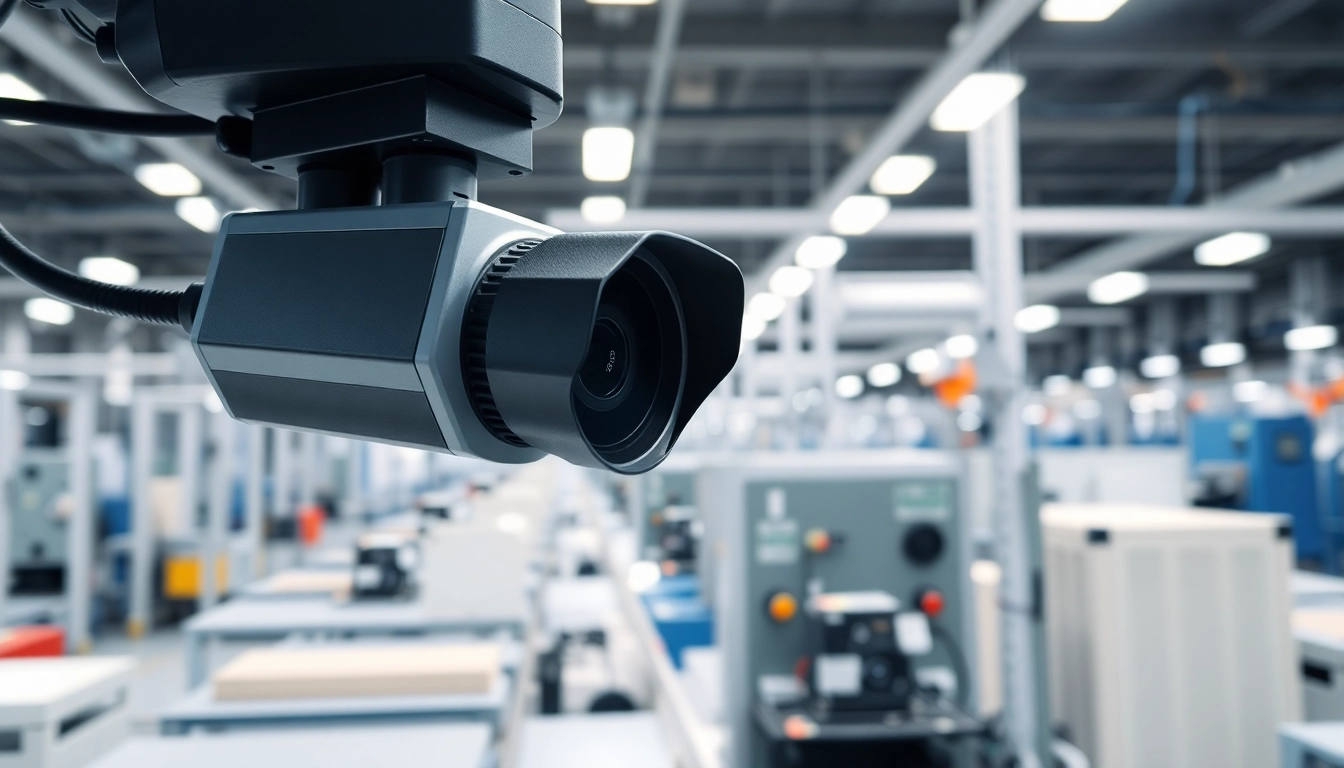What is Machine Vision?
Definition and Overview
Machine vision refers to the technology and methodologies used to provide imaging-based automatic inspection and analysis. It is a branch of computer science that focuses on how computers can be made to gain understanding from digital images or videos. Originating from a combination of optics, image processing, and artificial intelligence, machine vision is used broadly in industrial applications for quality control, automation, and even guidance systems in robotics.
This technology allows machines to “see” and make decisions in real-time based on image data. Essentially, it serves the critical role of enabling automated systems to interpret visual information, streamlining processes, and enhancing operational efficiency. For a detailed exploration of the capabilities and implementation of machine vision, consider this resource on machine vision.
Key Components of Machine Vision Systems
A machine vision system typically consists of several key components:
- Cameras: These capture images or video of the object being inspected or analyzed. The type of camera used can vary depending on the application; common choices include CCD (charge-coupled device) and CMOS (complementary metal-oxide-semiconductor) cameras.
- Illumination: Proper lighting is crucial to highlight the features of the object being inspected. Different types of lighting—such as LEDs, lasers, or ambient light—can be employed based on the environment and the specifics of the task.
- Processing Unit: This part involves hardware (like computers and GPUs) that processes the captured images using advanced algorithms to extract meaningful data.
- Software: Specialized software interprets the data from the processing unit, enabling functionalities such as image analysis, pattern recognition, and decision-making.
- Output Devices: Results generated by the software are usually provided through screens, alerts, or connected machinery that adjusts operations based on the findings.
How Machine Vision Works
The process of machine vision can be broken down into several stages:
- Image Acquisition: Cameras take snapshots or stream video of the target object. This is often enhanced with various lighting techniques to ensure optimal image capture.
- Image Processing: The captured images are converted into a digital format that can be analyzed. This may include noise reduction, scaling, and contrast adjustments.
- Feature Extraction: The software analyzes the image for specific characteristics or patterns—this can involve edge detection, color distribution, or shape recognition.
- Decision Making: Based on pre-programmed thresholds or parameters, the system decides whether the subject meets quality standards or if a specific action should be taken.
- Results Output: Finally, the outcomes of the analysis can trigger alerts, document findings, or automatically adjust equipment settings.
The Applications of Machine Vision in Industry
Quality Control and Inspection
One of the primary applications of machine vision is in the realms of quality control and inspection. In manufacturing environments, machine vision systems are employed to ensure that products meet defined quality standards. By analyzing images of products on production lines in real-time, these systems can detect defects, measure dimensions, and verify that items are assembled correctly.
For example, a machine vision system might be used on an automotive assembly line to inspect the placement of components and ensure that all parts are correctly aligned before the next stage of production begins. The ability to instantly identify defects reduces the number of faulty products that reach consumers, ultimately leading to higher customer satisfaction and lower return rates.
Automation in Manufacturing Processes
Automation is another critical area where machine vision excels. By combining machine vision capabilities with robotic systems, manufacturers can create highly automated processes that significantly increase efficiency. For instance, in warehouses and distribution centers, robots equipped with machine vision can identify products, sort them, and determine optimal packing arrangements without human intervention.
Such automation minimizes human error, speeds up production rates, and makes it possible to operate machinery around the clock, maximizing uptime and operational efficiency. Moreover, this technological synergy allows businesses to adapt quickly to changing demands, increasing their competitiveness in the market.
Use Cases in Different Industries
Machine vision technology is versatile and applicable in numerous industries beyond manufacturing:
- Pharmaceuticals: In the pharmaceutical industry, machine vision systems are critical for verifying labels, checking packaging integrity, and ensuring compliance with regulatory standards.
- Aerospace: Aerospace manufacturers use machine vision for inspecting critical components to ensure safety and reliability in parts used in flight operations.
- Electronics: In electronics manufacturing, machine vision is employed for tasks such as inspecting circuit boards, ensuring components are properly soldered, and measuring fine details.
- Food and Beverage: Machine vision ensures packaging integrity, checks for contaminants, verifies labeling, and monitors production processes to maintain high quality and safety standards.
Benefits of Implementing Machine Vision Technology
Improving Efficiency and Productivity
The integration of machine vision in various processes typically results in substantial improvements in efficiency and productivity. By minimizing the need for manual inspection, companies can reduce labor costs and free up skilled workers for more complex tasks. Automated vision systems operate continuously, ensuring consistent monitoring and allowing for high-throughput production rates.
Cost Reduction and Resource Allocation
In addition to increasing efficiency, machine vision systems contribute to significant cost savings. By catching defects early in the manufacturing process, businesses can decrease wastage and lower the costs associated with rework or product recalls. This allows for more effective allocation of resources and better budget management.
Enhancing Product Quality and Safety
Implementing machine vision enhances quality assurance processes, ensuring high standards are consistently met. With the ability to analyze products on the fly, manufacturers can prevent defective items from reaching customers, thus safeguarding both brand reputation and consumer safety. This leads to higher customer satisfaction and loyalty, driving long-term business success.
Challenges and Considerations in Machine Vision
Common Issues in Implementation
While the benefits of machine vision are substantial, there are also challenges to consider during implementation. One common issue is the initial setup cost, which includes the purchase of cameras, lighting, processing units, and software. Businesses may also face difficulties in training staff to utilize and maintain the systems effectively.
Technological Limitations
Another potential challenge lies in technological limitations, such as the inability of standard cameras to capture high-speed objects or the inability to recognize certain materials under specific lighting conditions. Therefore, careful consideration must be given to the selection of equipment and systems that best suit the specific application requirements.
Integration with Existing Systems
Integration of machine vision systems with existing equipment and workflows can pose significant challenges. Organizations may need to invest in custom software solutions or work with vendors to ensure compatibility with existing machinery and technologies. It’s crucial to involve key stakeholders from all levels of the organization during this process to facilitate a smoother transition.
The Future of Machine Vision
Emerging Trends and Innovations
The future of machine vision is bright, characterized by continuous innovations. Advances in AI and deep learning have transformed the capabilities of machine vision systems, enabling them to not only detect flaws but also predict potential failures before they occur. Technologies such as hyperspectral imaging and 3D vision are on the rise, providing even more depth to machine vision data and applications.
The Role of AI in Advancing Machine Vision
Artificial intelligence is set to further revolutionize machine vision, allowing systems to learn from each inspection cycle to improve accuracy and operational efficiency. By utilizing large datasets and machine learning algorithms, systems can dynamically adapt to various conditions and become more adept at recognizing complex patterns that were once challenging to detect.
Predictions for Industry Growth and Adoption
As industries increasingly recognize the importance of automation and quality control, the growth of machine vision technology is expected to expand significantly. Analysts project that the global machine vision market will grow exponentially over the next decade, driven by demand in sectors such as manufacturing, logistics, and healthcare. This trend will enable organizations to remain competitive and adaptable in an ever-evolving landscape.


